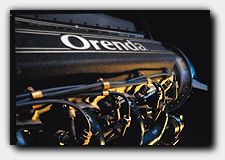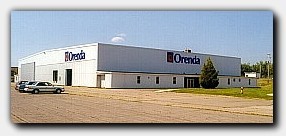 |
 |
VS. |
 |
Engine Wars.... Who will be the Winner?
| 12/07/98 AAFO.COM UPDATE Being somewhat of a "tech-head" I like to stay on top of current developments within the air racing classes... in particular the newly formed Sport Class. There are some very interesting developments in the aviation industry which made the timing of the introduction of Sport Class Racing to the National Championship Air Racing circuit about as good as it could get. Yes, we will always have the reliable Lycoming and Continental engines, their record is unquestionable and they will remain a viable powerplant option for years to come. However, we are now at the dawn of seeing two potential race winning engines take to the Reno pylons. These powerplants have yet to show their hand in Sport Class racing competition, but they will surely re-write the book once introduced. The two engines that will be pitted against each other are the Ryan Falconer V-12 and the Orenda OE-600 V-8. The Falconer engine first appeared at Reno '97, in the Thunder Mustang. Developed by Ryan
Falconer Industries (RFI), it has been used in racing boats, |
| Ryan Falconer's history in engine development began
while working for Andy Granatelli building the Novi engines for the Indy 500. For the past
29 years his company has built engines for numerous racing teams, including winners of the
Indy 500 and other prestigious races. Former boss, Andy Granatelli, as well as Roger
Penske, and Galles Racing have been among his Indy customers. In 1973 Ryan began
development work for Chevrolet. He has supplied engines to many of the top racing teams in
Can-Am and Trans-Am. In 1980 Ryan was asked by Chevrolet to develop the first V6 Chevrolet Indy engine, which qualified and completed the 500. In 1984 development began on the Chevrolet GTP Corvette, which gained considerable notoriety in the GTP racing series. At the completion of the V6 GTP project, Falconer was developing over 1200 HP from his 3.0 liter V6 engine. It was during this time that Ryan first decided to look into building a V12 engine and thus, the beginning of the V12 Falconer. But what is an engine without the components to turn that
horsepower into speed? The gearbox on the Falconer was The propeller for the Thunder Mustang is an 8 foot diameter, constant-speed, 4-blade, manufactured by MT Propellers. Many hours of extensive engineering and consultation was involved in arriving at the optimum design of each component of this system. The gear box ratio of 2.8:1 turns the prop 1607 rpm for the optimum ratio and for the best prop efficiency at high speed with the V12 turning 4500 rpm. The 100 lb. propeller is of composite construction utilizing a wood core, which is self dampening and non-fatiguing. This saves weight compared to metal propellers and reduces the gyroscopic effect of the prop on take-off. The Ryan Falconer V12 is a very impressive engine with a lot of sound engineering and data to support it. At first glance you would say (as I did) that this powerplant will be unstoppable, it will dominate Sport Class racing...... Well, there’s another engine that’s out there that will be able to give the Falconer a run for its money - and we may see this one in a Lancair Tirgress at Reno ‘98. |
Orenda Recip. Inc. has developed a new engine for general aviation applications, the OE-600. It is the first new high-output piston engine to be certified in over 40 years.(US and Canadian type approvals) Not only does this speak well of the engine, but also to the commitment of Orenda to the manufacture and sales of their new offering. Orenda is a subsidiary of Magellan Aerospace Corporation, a publicly listed company on the Toronto Stock Exchange. The company specializes in aerostructures, industrial and aero-engines, and turbine engine component manufacture, repair and overhaul. Annual revenues are in excess of $420 million. We’re talking a serious player here, and one that has the
resources to make the OE-600 a serious competitor within Sport Class As I said earlier, the timing of the introduction of Sport Class air racing could not have been better. The world's first kit-built aircraft powered by the new Orenda Series OE-600 V8 was on display at the Lancair booth at the 45th annual Oshkosh Convention. The Tigress, a two-place, composite single designed around the Lancair IV, is designed to achieve a maximum speed of over 400 mph. This will put it in the same league as the Thunder Mustang with its Falconer V-12. |
 Right now, the big difference is in the price for one of these beauties
(Orenda vs. Falconer). However, Orenda has opened a new manufacturing facility in Delbert,
Nova Scotia, near Halifax. At full capacity the plant will churn out 60 of the OE-600
engines per month. So far, 180 engines are on order. Initial applications include the
retrofitted Beech King Air C90B and Rockwell Twin Commander business aircraft; de
Havilland Canada Beaver and Otter bushplanes; the Airtractor agricultural aircraft; and
the Lancair Tigress kitplane. Supplemental Type Certificates are currently underway for
these aircraft. Bottom line here is that the price will drop in time, and should be an
attractive option for kit builders who plan to take their creations to the racecourse. (or
just want to go really fast!) Right now, the big difference is in the price for one of these beauties
(Orenda vs. Falconer). However, Orenda has opened a new manufacturing facility in Delbert,
Nova Scotia, near Halifax. At full capacity the plant will churn out 60 of the OE-600
engines per month. So far, 180 engines are on order. Initial applications include the
retrofitted Beech King Air C90B and Rockwell Twin Commander business aircraft; de
Havilland Canada Beaver and Otter bushplanes; the Airtractor agricultural aircraft; and
the Lancair Tigress kitplane. Supplemental Type Certificates are currently underway for
these aircraft. Bottom line here is that the price will drop in time, and should be an
attractive option for kit builders who plan to take their creations to the racecourse. (or
just want to go really fast!)So, who will win in this engine war? Well, that’s easy..... the kit builders and race fan will be the true winner. Competition breeds innovation and more importantly, better quality products at reduced prices. As some well placed individuals have stated before, the future of air racing may indeed lie within the new Sport Class..... and with affordable high-output piston engines, the future of air racing looks bright indeed. Reno ‘99 is right around the corner, and I for one can hardly wait to see these beauties battle it out for top honors. Hard to say who or what aircraft type will be the winner, or what engine will power it to victory. But one thing is certain - if sentiment counts for anything, I’ll be pulling for the Thunder Mustang ;-) |
Story by: Mark Kallio |
|
|
related links: |
[home][air racing][photo gallery][general-military-history][links][news][sims][site map]
copyright ©1997-98 Airport Fence Productions, Inc.
-All Aviation FlightLine OnLine-
Reproduction of any part of this website,
without prior permission, is forbidden.